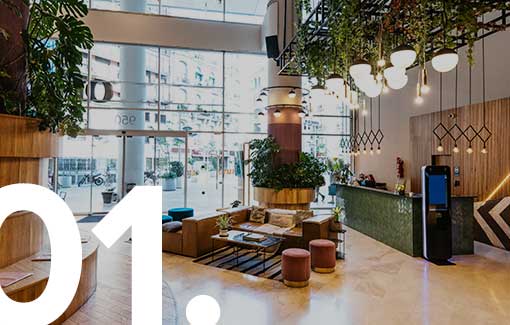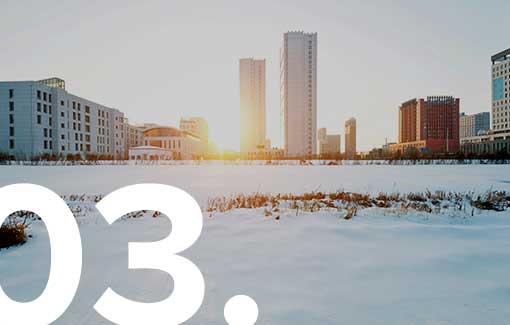
How Engineers Use Electric Heat to Create Comfort
Electric heat is the future of heating and cooling, and a key component in achieving the goal of the all-electric building or facility. Whether installed in a home or a high-rise, a heating system is only as good as its building’s coldest room. Comfort is key when it comes to productivity and contentment. Despite the collective groan over the cost of electricity, the push for net zero energy building is forcing its use. Fortunately, HVAC technology is evolving. Engineers developed electrically powered systems that are more effective and provide users with comfortable environments in which to work and play. Being warm, however, is not the only thing that an engineer must consider when using electric heat. Many factors must be evaluated to offer consumers heating and cooling solutions that satisfy their varying needs and, ultimately, provide them with space they can inhabit comfortably. As the move to all electric HVAC gains speed, variable refrigerant flow (VRF) systems are rising in popularity as the best alternative to fossil fuel sourced systems. Engineers use multi VRF system technology to provide consumers with heat that is cleaner, more efficient, and effective. Variable refrigerant flow systems do less damage to the environment than traditional forced-air systems, while offering the same level of comfort—except when the temperature drops.
“Supplemental technology is required to make VRF systems fully functional in all environments.”
Unfortunately, VRF systems failed to be the one-source solution to electric heating and cooling they were promised to be. Supplemental technology is required to make such systems fully functional in all environments. Typical VRF supplements include additional heating units that keep refrigerant flowing when the temperature falls below 20⁰ F. While most supplements are acceptable, most increase cost and loss of energy and heat. Engineers are finding that Radiant Electric Heat’s (REH) infrared electric heat panels are more effective and more efficient as VRF supplement heat pumps—if not full replacements—in the creation of comfortable spaces for consumers. Radiant Electric Heat’s unique CeramiCircuitTM technology guarantees thermal comfort anywhere with any HVAC system. Standard electric heat panels are known for being fragile, expensive, and inefficient, with resistive elements that experience breakage and failure as they expand and contract during heating processes. Typical heat panels produce heat after they have powered on but immediately cool when powered off, requiring constant energy use which increases the cost to maintain a stable temperature in a building. In contrast, REH’s panels with their proprietary element comprised of a carbon steel core, porcelain coating and aluminum oxide resistive trace, allows REH panels to immediately produce heat when turned on and to continue emitting heat while powered down when the thermostat cycles off. This slow release of heat energy from the carbon steel core creates very even temperatures, maximizing efficiency and occupant comfort. Engineers looking to offer consumers consistent heat output are finding REH’s CeramiCircuitTM technology a welcome alternative to traditional electric heat panel technology and other supplemental HVAC equipment. Occupants in buildings with REH panels are warmer quicker and for longer periods of time, enjoying increased comfort while using less energy due to their 52% greater downward radiant output per watt than competing radiant heaters. While VRF systems can deliver heat to most parts of a building, there are some places that it just cannot reach. Engineers can quickly and easily install REH’s panels anywhere they are needed. Installation is available by three different methods: lay-in ceiling, surface or suspended ceiling mount, or wall mounted cove. The sizing of the installed heat load is customized to the requirements of the building—and to accommodate individual occupant comfort.
“It is not rare to find employees wearing winter coats at their desks while others in the same exact office are donning t-shirts.”
 It is not rare to find employees wearing winter coats at their desks while others in the same exact office are donning t-shirts. Engineers use zoning to create environments that are more tailored toward individuals in a space rather than relying on the common but ineffective, one-temperature-fits-all approach to heating and cooling. Radiant Electric Heat’s panels allow engineers infinite zoning possibilities.
If there is an old, drafty stairwell that people avoid using, an REH panel or two can be installed in no time to dissuade daily races to the elevator. A wall with floor-to-ceiling windows leaves employees with adjacent cubicles shivering in a VRF-run facility, but adding a few REH panels will keep them at their desks blanket free. Engineers can design a space with as many or as few REH panels as necessary. The panels can share controls or have separate controls, and sensors can be used to trigger the units to run or shut down based on occupancy, meeting commercial building energy conservation code and decreasing cost. Infinite zoning makes it possible to keep everyone in the office comfortable.
There is, however, more to comfort than temperature. Noise, air flow, and ventilation are additional factors that engineers consider when selecting the best heating and cooling systems for Radiant Electric Heat’s panels are silent, create no air movement, and require no ventilation to operate safely.
Safety has always been a primary concern with HVAC systems, but health safety has not been a large part of it. With the inception of COVID-19, business owners are more concerned than ever about implementing systems with increased ventilation, air turnover, improved air filters, and other features that decrease the potential of viral exposure and spread. While traditional heating system technology has been updated and is advancing to address these concerns, supplementing or replacing such systems with REH’s panels paired with proper ventilation, and relying on CeramiCircuitTM Technology for safe, effective, and healthy heating should be considered as not just an alternate option, but the primary solution.
Implementing Unidirectional Flow Ventilation or UDF in place of Traditional Mixing Ventilation or TMV, could be a solution in reducing viral transmission in many occupied spaces. UDF has already been successfully utilized in operating theatres and clean rooms and could be a solution to reducing COVID-19 and other viral transmission in many other applications. Studies have found it is an effective ventilation system that reduces airborne bacterial burden under real clinical conditions by more than 90%. Introducing cooler supply air with returns placed opposite to the supply source, and using CeramiCircuitTM Radiant Panels to create comfort, the disruption of air-flows and mixing of air and pathogens are greatly diminished, sweeping viral aerosols and droplets out of the occupant contact zone and reducing the risk of transmission. REH panels, having 52% greater downward radiant output than competing units, are the ideal choice for this application as their industry leading output will easily negate the effects of the cooler supply air.
It is not rare to find employees wearing winter coats at their desks while others in the same exact office are donning t-shirts. Engineers use zoning to create environments that are more tailored toward individuals in a space rather than relying on the common but ineffective, one-temperature-fits-all approach to heating and cooling. Radiant Electric Heat’s panels allow engineers infinite zoning possibilities.
If there is an old, drafty stairwell that people avoid using, an REH panel or two can be installed in no time to dissuade daily races to the elevator. A wall with floor-to-ceiling windows leaves employees with adjacent cubicles shivering in a VRF-run facility, but adding a few REH panels will keep them at their desks blanket free. Engineers can design a space with as many or as few REH panels as necessary. The panels can share controls or have separate controls, and sensors can be used to trigger the units to run or shut down based on occupancy, meeting commercial building energy conservation code and decreasing cost. Infinite zoning makes it possible to keep everyone in the office comfortable.
There is, however, more to comfort than temperature. Noise, air flow, and ventilation are additional factors that engineers consider when selecting the best heating and cooling systems for Radiant Electric Heat’s panels are silent, create no air movement, and require no ventilation to operate safely.
Safety has always been a primary concern with HVAC systems, but health safety has not been a large part of it. With the inception of COVID-19, business owners are more concerned than ever about implementing systems with increased ventilation, air turnover, improved air filters, and other features that decrease the potential of viral exposure and spread. While traditional heating system technology has been updated and is advancing to address these concerns, supplementing or replacing such systems with REH’s panels paired with proper ventilation, and relying on CeramiCircuitTM Technology for safe, effective, and healthy heating should be considered as not just an alternate option, but the primary solution.
Implementing Unidirectional Flow Ventilation or UDF in place of Traditional Mixing Ventilation or TMV, could be a solution in reducing viral transmission in many occupied spaces. UDF has already been successfully utilized in operating theatres and clean rooms and could be a solution to reducing COVID-19 and other viral transmission in many other applications. Studies have found it is an effective ventilation system that reduces airborne bacterial burden under real clinical conditions by more than 90%. Introducing cooler supply air with returns placed opposite to the supply source, and using CeramiCircuitTM Radiant Panels to create comfort, the disruption of air-flows and mixing of air and pathogens are greatly diminished, sweeping viral aerosols and droplets out of the occupant contact zone and reducing the risk of transmission. REH panels, having 52% greater downward radiant output than competing units, are the ideal choice for this application as their industry leading output will easily negate the effects of the cooler supply air. Related Articles
Conventional methods of heating and cooling increase air circulation but contribute to poor indoor air quality. However, supplementing or replacing a traditional HVAC system with a radiant heating system can improve indoor air quality and decrease the risk of airborne infection.
- What causes poor indoor air quality
- COVID-19 and IAQ products
- Addressing air quality issues
Electricity plays a major role in the push for dependence on renewable energy and the development of net zero energy buildings. Radiant heating systems are electrically powered and nullify the need for traditional energy sources. They are instrumental to adaptation and renewable sources of energy.
- Electricity: Cleaner, more efficient comfort
- The benefits and pitfalls of VRF system HVAC
- Direct source-to-object heating solutions
VRF system HVAC is considered the top-of-the-line setup for electric heating and cooling—until the temperature drops. Cold climates impair VRF system functionality. Fortunately, there are some simple ways to boost the performance of VRF systems in commercial buildings and other structures.
- Recent advances that make VRF the best electric HVAC option
- Cold weather: The VRF Achilles heel
- The best heat pump supplements


